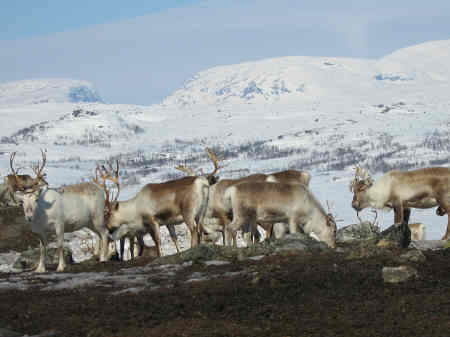This post is pretty much an extension of some seminar work I did last week, but whilst I was researching it I became really interested, and thought it was worth sharing here, albeit a little late.
_______________________________________________________________________________
The Saami people are the indigenous population of Norway (Borgos 2009). Saami skeletons have been the subject of controversy for some time now, with numerous cases being brought to light recently of the debate between those who wish to complete research using the remains, and the Saami people themselves. Some of the skeletons are up to 1000 years old.

The Saami were reliant on reindeer for survival (from articpeoples.net - accessible at http://www.arcticpeoples.org//uploads/2008/02/ome-photo.jpg)
The indigenous population of Norway lives in the Northernmost areas of Sweden, Finland, Russia and Norway known as Sápmi (Borgos 2009). The majority of Saami people now live in Norway, although much smaller numbers still remain elsewhere in the Sápmi area. Originally nomadic, they would follow the reindeer herds in order to sustain themselves through hunter gathering subsistence.

Neiden and the Sápmi area (From Aftenposten.no - accessible at http://www.aftenposten.no/migration_catalog/article5778638.ece/BINARY/w380/neiden.jpg)
94 skeletons of the native Saami peoples of the Skolt Saami minorities based on the borders of Finland, Russia and Norway (Karlsbakk 2011) have been held in the University of Oslo since 1911 (Somby 2008), where researchers had bought them to study for less than one Euro per individual skeleton. After 94 years they were finally returned to their original burial site at the edge of the river Neiden (Karlsbakk 2011).
Researchers wish to study the origins of the indigenous Saami people by comparing contemporary Saami DNA with the DNA obtained from the ancient Saami skeletons (Clark 2011). Such research could be used to link current living human beings with their past and connecting them with the population of Norway in the past. The DNA from 62 skeletons has been used to determine maternal DNA clusters, and this can be connected to already known mtDNA sequence polymorphisms in Saami populations across Europe and Asia (Delghandi et al. 1998). There are two major divergent mtDNA lineages, and this is indicative of there being two phases of migration independent of one another into Northern Scandinavia, one of which created a very diverse lineage, whereas the other became significantly less varied (Delghandi et al. 1998).

Saami family (from wikipedia.org - accessible at http://upload.wikimedia.org/wikipedia/commons/thumb/8/87/Saami_Family_1900.jpg/350px-Saami_Family_1900.jpg)
The University of Oslo has issued an official apology for the ‘unlawful intervention in an indigenous peoples group’s human rights.’(Karlsbakk 2011).
The Saami parliament is opposed to research such as this being carried out on the bones of their ancestors, and current legislation means that special permission from them is necessary in order for such work to be carried out. The Saami people have attempted to bring back the remains to Neiden several times in the past, but these were unsuccessful mainly due to monetary issues.
The removal of the remains from their burial site has been called grave robbery by some descendants (Karlsbakk 2011). A lot of the Saami parliament are suspicious of the motives behind the proposed research, and do not want it to be used for political motives.
However, not all of the Saami descendants disagree with the research that is under demand to be carried out. For example, Karina Mathisen, whose great grandmother was a Skolt Saami, thinks that by analysing those remains already dug up before their repatriation and reburial would be an excellent chance to learn about their heritage.

Saami at spring celebration (from blog.norway.com - accessbile at http://blog.norway.com/wp-content/uploads/2011/11/48033905_dca34fbd7e.jpg)
There are currently up to 1000 Saami skeletons stored in the Anatomical Institute in Oslo, but they are kept separate from other remains used for research (Clark 2011). Currently, if any human remains uncovered on excavations have any possibility of being of Saami origin, they are not permitted to be removed. They can be examined only on site, and must then be reburied where they were found (Clark 2011).
This, of course, is relatable to the larger debate surrounding the repatriation and reburial of human remains, specifically those of indigenous groups. As always, there are those who believe that the value of the knowledge far outweighs the objections of these groups of people, but it is perhaps unfair to come to this conclusion when they have not experienced it themselves. Whilst we can gain valuable insight from these human remains, we must stop to think how we would feel if it were our own ancestors. It has become impossible to satisfy both sides of the debate, and there will always be controversy surrounding such cases. however at least in this instance they seemed to have reached an effective compromise, which, whilst not ideal, is better than either denying access to remains at all or completely ignoring the requests of the Saami.
Bibliography
Delghandi, M., Utsi, E., Krauss, S. 1998. Saami mitochondrial DNA reveals deep maternal lineage clusters. International Journal of Human and Medical Genetics: Human Heredity 40 [2] 108-114. http://content.karger.com/ProdukteDB/produkte.asp?Aktion=ShowFulltext&ArtikelNr=22789&Ausgabe=225921&ProduktNr=224250#SA3 [Last accessed 6th Dec 2011]
Karlsbakk, J. 2011. 94 Saami skeletons brought to final rest. http://www.barentsobserver.com/94-sami-skeletons-brought-to-final-rest.4964719.html [Last accessed 5th Dec 2011]
Clark, T. 2011. Skeleton in the Closet. http://blog.norway.com/2011/11/16/skeleton-in-the-closet/ [Last accessed 6th Dec 2011]
Somby, L. I. 2008. Norway: Sami skeletons coming home. http://www.galdu.org/web/index.php?odas=3335&giella1=eng [Last accessed 6th Dec 2011]
Rapp, O. M. 2008. Navnløsse skjeletter flyttes til Finmark. http://www.aftenposten.no/nyheter/iriks/article2708742.ece [Last accessed 6th Dec 2011]
Borgos, J. I. 2009. The Sami People. http://www.borgos.nndata.no/samer.htm [Last accessed 6th Dec 2011]

